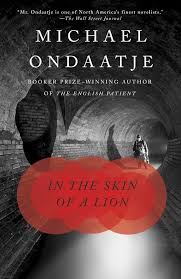In the Skin of a Lion, Michael Ondaatje

Published in 1987 by Canadian-Sri Lankan author Michael Ondaatje, his novel InThe Skin of A Lion is the story of three individuals in Industrial Revolution Age Toronto, Ontario, whose lives become intertwined throughout the story. His novel follows Patrick, whose family immigrated to Ontario, as he moves into Toronto’s a young man in search of work, like so many others who were promised a life of prosperity in the New World of the West. As Patrick lives a life filled with adventure, Ondaatje also introduces the character of Nicholas Tirpak, a bridge worker whose job was to fly suspended in the air underneath bridge archways, pausing to do repairs when necessary. Based on a real life archival photo of an immigrant named Nicholas Tirpak who worked on the Bloor Viaduct in Toronto during the early 20th century. Using fictional characters and blending aspects of archival facts regarding the industrial construction of the city of Toronto by mainly immigrant workers, Ondaatje writes back again the metanarrative of history detailed in archive pictures, government documents, and newspapers by the media that depict the period as being a time of only great progress, wealth, innovation, and expansion. Through his immigrant characters, Ondaatje creates a story that details the experiences of the immigrant worker in Canada in the early 19th century and what they were subject to by the government during this time. Ondaatje details the dangers and frequent deaths of the bridge workers for little pay, the unhygienic and unsafe working conditions of mines and construction projects, and also showcases the rising socialist ideas of the characters in the novel who argued against the current treatment of the working class, such as the ex-nun Alice and her role in a play at a secret meeting at the waterworks.
Throughout the story, Ondaatje changes the grand narrative of history, and prompts contemporary readers to discover the hidden stories not told by official government documents, archives, and newspapers of the time so as to avoid bias and ignorance regarding the age of the industrial revolution and its negative implications for immigrants and the working class. Michael’s invention of a story for a real life person depicted in a bridge photograph in 1918 forces the reader to ask the question: What is this person’s story? This book is written with poetic language and hypnotic descriptions that change the perception of one of Canada’s greatest cities in popular culture from one experience felt linearly by all, into a unique experience felt differently by diverse group of people across the province. This book relates to critical thinking as it forced the reader to recognize our own bias regarding our “knowledge” of a certain period or event and understand that there is no “true” experience or definition, opening our minds to new ways of thinking about something, increasing our collaboration skills, empathy, creativity, and re-framing skills.
